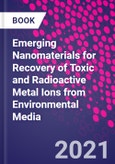Emerging Nanomaterials for Recovery of Toxic and Radioactive Metal Ions from Environmental Media covers nanomaterials used in the environmental remediation of sites contaminated by toxic or radioactive heavy metals. The book comprehensively covers the use of MOF-based nanomaterials, COF-based nanomaterials, MXene-based nanomaterials, nZVI-based nanomaterials and carbon-based nanomaterials in remediation techniques and details the main interaction mechanisms between toxic/radioactive metal ions and the described novel nanomaterials through kinetic analysis, thermodynamic analysis, spectroscopic techniques and theoretical calculations. It provides a thorough reference on the use of the described novel nanomaterials for academics, researchers and advanced postgraduates in the environmental sciences and environmental chemistry.
Please Note: This is an On Demand product, delivery may take up to 11 working days after payment has been received.
Table of Contents
1. Novel nanomaterials for environmental remediation of toxic and radioactive metal ions2. Water-stable metal-organic framework (MOF) based nanomaterials for removal of heavy metal ions and radionuclides
3. Applications of covalent organic framework (COF) based nanomaterials as superior adsorbents in wastewater treatment
4. Two-dimensional transition metal carbide/nitride (MXene) based nanomaterials for removal of toxic/radioactive metal ions from wastewater
5. Adsorptive and reductive removal of toxic and radioactive metal ions by nanoscale zero-valent
6. Water treatment and environmental remediation applications of carbon-based nanomaterials
7. Theoretical calculations of toxic/radioactive metal ions capture by novel nanomaterials
8. Summary and future outlook








